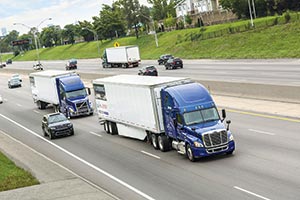Connected Vehicles, Platooning Coming Into Focus

This story appears in the February 6 print edition of iTECH, a supplement to Transport Topics.
WASHINGTON — Connected vehicles and platooning are two of the major technological developments coming soon to trucking, and manufacturers, fleets, regulators and academics are wrestling with the details now.
Vehicle-to-vehicle and vehicle-to-infrastructure systems, also known as V2V and V2I, are moving toward the nation’s highways because of a recent proposed federal rule for cars and light trucks and some guidance that is expected, panelists said here Jan. 10 during the Transportation Research Board’s annual meeting. The same group also looked at developments in platooning.
Both technologies use active safety systems from suppliers such as Bendix Commercial Vehicle Systems and Meritor Wabco as a basis. There was a consensus among speakers that driverless trucks on U.S. highways are not likely soon.
BEST OF FEBRUARY iTECH: More stories, columns
“Most of [the current technology] was developed for the convenience of the driver and for safety. We’re looking for ways to relax the driver, not replace him,” said Susan Alt, a senior vice president for Volvo Group North America, which manufactures Volvo and Mack Trucks.
“Let us never again describe these as driverless vehicles,” said Daniel Murray, vice president of the American Transportation Research Institute, or ATRI. Trucks that offer autonomous driver assistance are not the same as driverless, he said.
Asked about following vehicles in platoons and if they will be driverless, Murray replied, “Not in my lifetime. … I don’t think we want to take the drivers out of the last trucks.”
Steve Boyd, a vice president and co-founder of Peloton Technology, reiterated his company’s projection that its personnel will be conducting platoon tests with fleets this year. While he offered no details on the tests, he did summarize the differences between what platooning will look like at first versus what it could be in the future.
Platooning, which uses dedicated, short-range communications — also a part of V2V — will start with two-truck teams and a driver operating each one. Peloton’s current system offers only distance control, not steering, and it is designed for large highways, Boyd said.
In the future, though, there could be three- or four-truck platoons with a driver in the lead truck only, which would add steering control, and they might run through cities as well as highways.
Boyd said he anticipates Peloton systems installed on new trucks at modification centers that are often adjacent to large truck-assembly plants.
A short but safe following distance is the key to the fuel economy benefits of platooning.
Matt Hanson, a divisional project manager for the California Department of Transportation, or Caltrans, said platooning systems can react in one-tenth the time of a person. Boyd said trucks using Peloton’s system can follow at 40 to 50 feet, depending upon the speed. But that was a problem for California, Hanson said, as the state vehicle code did not allow a highway following distance of less than 100 feet.
“Legislation was required for testing, and passing legislation is a heavy lift that takes a lot of time,” Hanson said.
Related to Hanson’s comments, Volvo’s Alt also offered observations on the nature of regulation that original equipment manufacturers face.
“Regulators are trying to keep the roads safe, but they also don’t want to push back on technology. … I think we’ll see a lot of regulations follow after technology. There’s a long time from concept to commercialization,” she said.
Alt cited electronic stability control, or ESC, as an example that could be repeated. The National Highway Traffic Safety Administration is making it mandatory on Classes 7 and 8 tractors starting in August, but it’s been available as an option for years and has generally been superseded by collision mitigation systems.
Alt also said third parties such as Peloton are helpful in research and development, as it is difficult for OEMs “to really push the envelope.”
“All of the testing takes so much time. [For] anything having to do with steering and brakes, you have to make sure that it’s safe in all conditions.”




